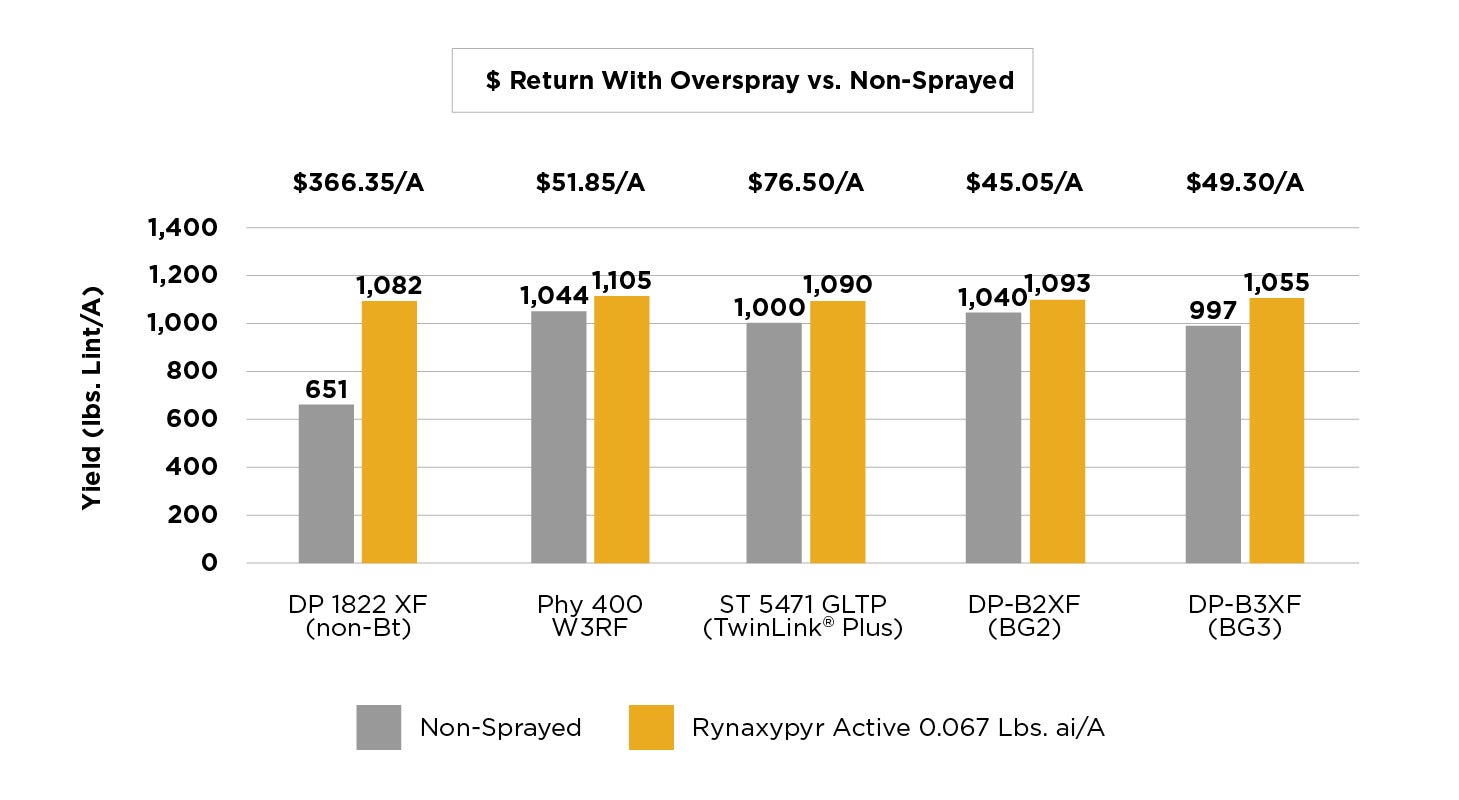Read the entire report from
our technical services team
One of the biggest challenges facing cotton producers in 2021 is the management of variable stands of cotton in the same field. In the Mid-South in both delta and hill cotton, this seems to be the norm rather than the exception with different stages of cotton intermingled in field after field. Making the correct decision when it comes to controlling insect pests will be more complex than ever before from planting through the maturity of the crop. Thrips tend to be the most common early-season insect, but as cotton approaches the bloom stage, we are seeing more treatments being made to control aphids, mites and plant bugs. As cotton starts to load fruit, worm pests such as cotton bollworm (Heliothis zea) become problematic. Bt-traited cotton varieties have offered good to excellent control on the worm complex, but due to Bt-resistant cotton bollworms, this technology is struggling to provide adequate protection from this particular worm pest.
Cotton bollworm damage to Bt-traited cotton varieties can occur under heavy bollworm pressure, but cotton yields may also be impacted by below-threshold populations that remain for extended periods. In either scenario, overspraying Bt cotton varieties with Vantacor™ insect control powered by Rynaxypyr® active has consistently demonstrated increased cotton yields. With extended residual protection and a low impact on many important beneficial insects, Vantacor insect control is the perfect choice in a Bt-overspray program to help maximize cotton yields.
The following summarizes five trials conducted by university Extension entomologists in the Mid-South/Texas area in 2020 on non-Bt, 2-gene and 3-gene cotton varieties. This shows the average return from an overspray of Rynaxypyr, the active in Vantacor insect control.
RYNAXYPYR ACTIVE OVERSPRAY PROGRAM ON BT COTTON VARIETIES
Mid-South/Texas - University Regional Project, 2020 (LSU, MSU, UAR, UT, TAMU) Average of five trials (AR, LA, MS, TN and TX).

Setting the Stage for Optimal Results: "1.7 @ 20”
Vantacor™ insect control at 1.7 fl. oz./A when 20% of plants have bollworm eggs
- Rate: Apply Vantacor insect control at 1.7 fl. oz./A
Vantacor insect control applied at 1.7 fl. oz./A provides control of cotton bollworms (1st-3rd instar larvae) while providing residual protection that lasts from 14-21 days. The extended residual feature of Vantacor insect control is the best of any cotton insecticide and is essential for plant protection when bollworm egg lay is extremely heavy or occurs over an extended period of time.
With low impact on many important beneficial insects, Vantacor insect control is a key component of an IPM program and, unlike pyrethroid-containing insecticides, does not flare secondary pests such as aphids and mites. - Timing: Apply Vantacor insect control when 20% of plants have bollworm eggs
Timing of the Vantacor insect control application is a critical factor for success and key to help maximizing cotton yields. It is very important to protect the cotton plant from damage during critical periods of square set and boll development. By allowing worms to hatch and damage to occur, yields can be significantly reduced. In addition to heavy bollworm pressure and damage, research has shown that cotton yields can also be negatively impacted by extended periods of sub-threshold damage.
Most university Extension entomologists across the Mid-South and Texas recommend making an application of Vantacor insect control when 20% of plants have bollworm eggs in dual-gene Bt cotton. This is a change from recent years and is a result of research and field observations showing the egg threshold as a better indicator of optimal treatment timing in dual-gene cotton varieties. The extended residual control feature of Vantacor insect control allows for precise timing of applications at egg thresholds and prior to the occurrence of damage.
Note: In 2019, consultants reported bollworm damage in triple-gene cotton where bollworm pressure was extreme and some fields were treated with Rynaxypyr, the active ingredient in Vantacor insect control. - Coverage: Use a spray volume that insures good coverage of the entire plant
Good spray coverage of the entire cotton plant is critical for control of bollworms that have hatched as well as for protection from worms hatching from eggs following the Vantacor insect control application. With the introduction of Bt-traited cotton varieties, bollworm moths have adapted by laying eggs throughout the entire plant canopy including on blooms, bloom tags and lower leaves, so coverage in the lower plant canopy is essential.
Consider coverage of the entire plant when choosing a spray volume and application method (ground vs. air). The minimum spray volume recommended on the Vantacor insect control label is 2 GPA by air and 10 GPA by ground. However, with large cotton plants and a dense crop canopy, higher spray volumes may be necessary for complete coverage.
Always read and follow all label directions, precautions and restrictions for use. Some products may not be registered for sale or use in all states. Vantacor insect control may not be registered for sale or use in all states. Contact your local FMC retailer or representative for details and availability in your state. FMC, the FMC logo, Rynaxypyr and Vantacor are trademarks of FMC Corporation or an affiliate. TwinLink is a trademark of BASF. ©2021 FMC Corporation. All rights reserved. 06/21



